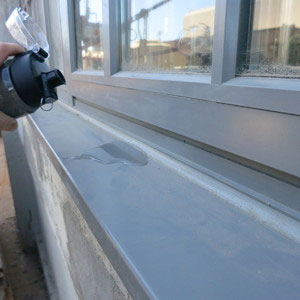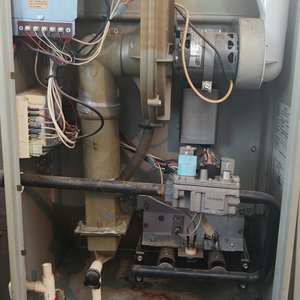
GBA reader Megnchris is experiencing one of the more frustrating parts of home ownership—dropping a chunk of cash on a repair doesn’t necessarily make the problem go away.
Writing in the Q&A forum, Megnchris (real name unknown) explains that repairs to the then 13-year-old house in 2016 led to the discovery of hidden rot.
“After much confusion and lots of conflicting advice from various contractors,” Megnchris writes, “we hired a stucco company to do the repairs. They told us the builder didn’t install flashing on any of the windows of the front of the house, and that the gutter-to-wall intersection either didn’t have a diverter or it wasn’t installed properly…thus the source of the leaking. The builder (now long out of business) put in the gutters then stuccoed around them at the wall-to-gutter intersection.”
Repairs cost $26,000, but Megnchris recently discovered fresh leaks around a bedroom window that had been replaced just last year. After removing some drywall, Megnchris found lots of wet wood and wet insulation in the wall, and checking other rooms with a moisture meter turned up similar problems there—all areas that had been tackled in the 2016 repairs.
“Where do we go from here?” Megnchris asks. “Based on the pictures of the repair work, could it still be the windows? We are beyond frustrated and anxious about whether or not the stucco company will honor their warranty…but even more worried that it will still not be resolved after it’s all said and done. ”
That’s the topic for the Q&A Spotlight.
There are several possible causes
Malcolm Taylor notes that there are several possible causes for the leaking walls: the windows themselves, the lack of a capillary break between the stucco and the sheathing, or improperly…
Weekly Newsletter
Get building science and energy efficiency advice, plus special offers, in your inbox.

This article is only available to GBA Prime Members
Sign up for a free trial and get instant access to this article as well as GBA’s complete library of premium articles and construction details.
Start Free TrialAlready a member? Log in















11 Comments
Why use conventional stucco? Synthetic stucco's like StuccoMax do NOT use cement so there are no cracks to deal with plus synthetics are waterproof, unlike conventional stucco.
Peter,
Synthetic Stucco was one of the major causes of the multi-billion dollar widespread envelope failure usually referred to as the BC Condo Crisis.
Peter L, could StuccoMax be installed over a rain screen:
- 1x3 furring over exterior (to sheathing) foam attached to studs using screws
- paper-backed lath or mesh attached to the furring strips
Thanks.
Poor materials like OSB show a bad quality of work. Proper stucco is waterproof. Portland, where is does rain, has nearly 100 year old stucco homes that are just fine.
>"Portland, where is does rain, has nearly 100 year old stucco homes that are just fine."
Many of those 100 year old stucco homes will have problems with retrofit insulation.
Which of the 2 dozen+ cities and neighborhoods in the US called "Portland" are you referring to?
Peter,
I've been inspecting stucco and synthetic stucco houses for 20 years now, and I can tell you that neither one is waterproof. Just like roofs, they leak at the "holes." Windows, doors, utility penetrations, roof edges - all the normal places. If water gets behind either one and the WRB details are wrong, the walls will rot. There are pros and cons to either one, or to the hybrids in between, but being waterproof is not a characteristic of any cladding system. That's why we have WRBs behind cladding systems in the first place, and why the first generation of EIFS failed so miserably in the 1980's
Im in NY 20miles north of manhattan (Zone 7a/6b) and have a big Andersen 400 6" x6" window set in stucco over the front door.
Every now and then when we get a thunderstorm coming from the north I get water leaking from this window inside, depending on the rainstorm will determine how much.
I have put real silicone caulk, in the joint between the window and the stucco and smeared it about 1/4" either side of the crack and by the looks of it the builder never sealed around the window (insulation wise just like he didnt do for every door and window opening in the house, which I've done but this window I havent done because its 15 foot off the ground.
So what to use to seal the outside of the window to stop the leaks?
I agree with Peter Engle. All stucco is porous. This is the reason there's a WRB behind the stucco. Sealing the stucco cracks will not stop the water intrusion.
I'd look for a consultant registered with IIBEC (formerly RCI). Either registered waterproofing consultant or registered exterior wall consultant.
Also, I've never heard a window manufacturer look at a leaking assembly and blame it on their windows, or a stucco installer blame it on their installation. If they don't know the cause, then it's always someone else's fault.
Finally, the window flange should be well integrated with the WRB. Self-adhered sheet flashings can work, but fluid-applied flashings are fool-resistant (nothing is foolproof in construction). Many manufacturers are offering fluid-applieds these days, my favorite being Prosoco's FastFlash. If you're recladding the whole house, then drainmat (rainscreen is a misnomer in this case) is always recommended.
" I've never heard a window manufacturer look at a leaking assembly and blame it on their windows, or a stucco installer blame it on their installation. If they don't know the cause, then it's always someone else's fault."
Exactly!
The only reason I tend to think it wasn't the windows was that the photos seem to show that a lot of the moisture damage was above the head.
Another update on our situation - we know that filling the cracks in the stucco is just a temporary fix, so we sat down with the stucco company and discussed the options as we saw them - either remove all the stucco from the front wall of the house and do it over again correctly as one continuous application, or refund the original repair. Since we are SO OVER stucco and don't want it reinstalled, we pushed for a refund. The stucco company agreed, so now we can put those dollars toward removing the stucco and replacing with siding instead. Thanks everyone for the comments, advice, and suggestions! ~Megan K.
Megan,
Wise move. Glad things are turning out.
Log in or become a member to post a comment.
Sign up Log in